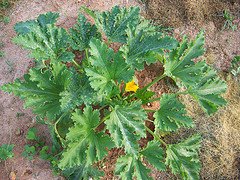Need Information About Growing Summer Squash?
We have all the information you need for successfully growing summer squash. Summer squash are easy to plant, easy to care for and easy to harvest. There are several different varieties of summer squash available to the backyard vegetable gardener. Most summer squash varieties can be grown in both container and traditional vegetable gardens. Most of the time, little effort is needed to get a bumper crop that can be used in a wide variety of recipes.

There are three main categories of summer squash:

Straightneck varieties of summer squash are easy to identify - they have a straight neck. Many are solid yellow in color, but they do come in green, gray, striped and bi-color. They are typically harvested when they are 6-12 inches long. Most varieties of straightneck squash are almost cylindrical in shape.

Crookneck varieties are also easy to identify - they are curved at the top. They are egg shaped at the bottom with a tapered, narrow neck. Most crookneck varieties are yellow in color and are harvested when they reach 6-12 inches long. Some varieties have a smooth skin, while others have visible bumps.

Scallop/Patty Pan varieties of summer squash are more unique and resemble minature flying saucers. They are usually yellow or green in color and are harvested when they reach 3-4 inches in diameter. These varieties usually have a slightly nutty flavor and are prized by professional chefs for their rich taste and unique shape.
Summer squash are usually grown on compact bush-type plants. They require at least 6-8 hours of daily, direct sunlight. Most bush varieties take up very little space and can be planted in 2 gallon containers. If grown in a traditional vegetable garden, summer squash are usually planted in hills or mounds a few feet apart.

The process of growing summer squash usually begins with seeds since transplants don't usually do well when their roots are disturbed. The squash are generally harvested at an immature stage when their seeds are still small and tender and before the skin becomes tough. Summer squash plants are abundant producers and will continue setting fruit for several weeks as long as you keep picking them.
Because they are such heavy producers, most people grow one summer squash plant for each member of their family. You can certainly grow more to give away to friends and relatives, but keep in mind that summer squash usually does not store very well on its own. It's possible to freeze it, but the texture tends to become limp and mushy. Summer squash is much better when sauteed, fried, roasted or served raw shortly after harvesting. Some people have tried to pickle summer squash, with varying results. Another great way to use up extra squash, or any other produce for that matter, is to use it to make a casserole. Some of these casseroles can be made ahead of time and stored in the freezer for later use.
Click on the following links for more detailed information about growing summer squash.

Click here to learn about planting summer squash
Click here for information about fertilizing and watering summer squash
Click here to learn about harvesting summer squash
Click here for information about different summer squash varieties
Click here for help with summer squash plant problems
Click here for summer squash recipes
Click here to move from our Growing Summer Squash page to our Home page